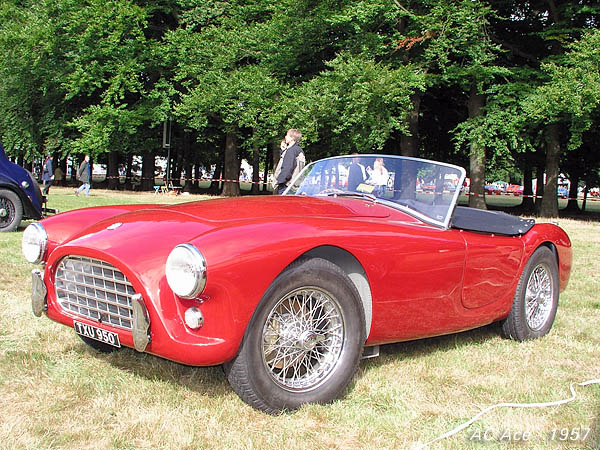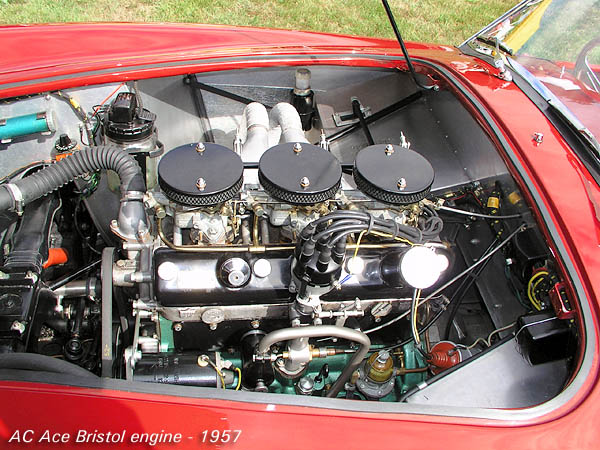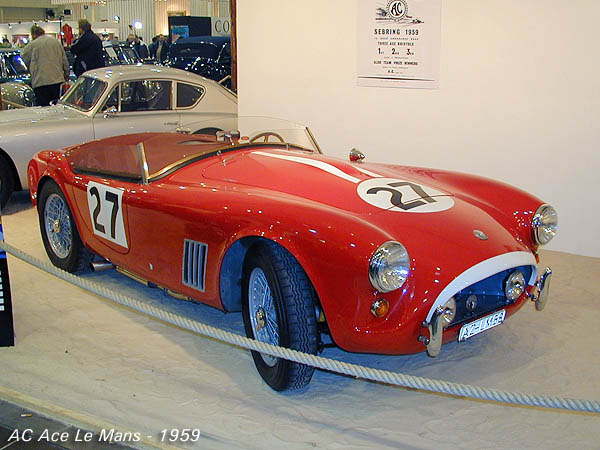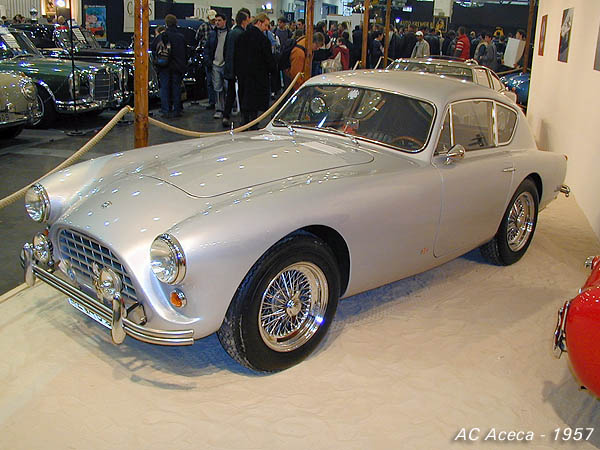|
 The roots of the Cobra go back to early post-war Britain where car trader Cliff Davis was enjoying some success in racing with his Cooper-MG special. To expand on this he commissioned John Tojeiro to build a new race car with a larger engine in 1952. Tojeiro was a gifted engineer who built racing specials as a sideline to his small business in painting and repairing bodywork. He constructed a lightweight tubular chassis with steel boxes in front and rear to support an independent suspension system. It was fitted with a 2-liter Bristol engine which was placed in front but near to the middle of the car for optimal balance. Then this chassis was finished with a nice barchetta-style 2-seater body by Gray and Rich Panelcraft, inspired by and similar to the barchetta body of the Ferrari 166MM made by Touring of Milan. The roots of the Cobra go back to early post-war Britain where car trader Cliff Davis was enjoying some success in racing with his Cooper-MG special. To expand on this he commissioned John Tojeiro to build a new race car with a larger engine in 1952. Tojeiro was a gifted engineer who built racing specials as a sideline to his small business in painting and repairing bodywork. He constructed a lightweight tubular chassis with steel boxes in front and rear to support an independent suspension system. It was fitted with a 2-liter Bristol engine which was placed in front but near to the middle of the car for optimal balance. Then this chassis was finished with a nice barchetta-style 2-seater body by Gray and Rich Panelcraft, inspired by and similar to the barchetta body of the Ferrari 166MM made by Touring of Milan.
Davis again had a very successful season in this nimble, lightweight car during 1953 and attracted a lot of attention with it. This Tojeiro-Bristol special, registered LOY 500, was to become the ancestor of a long line of sports cars and still is raced today.
 The match between the Tojeiro-Bristol special and AC Cars was both rapid and somewhat confusing. Tojeiro was ordered to build a car similar to the Cliff Davis car by Ernie Bailey, but this one was to be fitted with a more powerful Lea Francis engine. This Bailey had a coachwork company that manufactured the 5-seater tourer bodies which were offered on the venerable AC 2-litre chassis under the name of "Buckland" and were painted by Tojeiro in his regular line of business. Another man who got involved was Vin Davison, a garage owner who also owned the shed (which was next to his garage) rented by John Tojeiro for his business. Bailey was confronted with the dwindling sales of the AC 2-litre model, a very outdated car, and he and Davison saw an opportunity for the Tojeiro design at AC, who badly needed a replacement. So they introduced John Tojeiro to AC. The match between the Tojeiro-Bristol special and AC Cars was both rapid and somewhat confusing. Tojeiro was ordered to build a car similar to the Cliff Davis car by Ernie Bailey, but this one was to be fitted with a more powerful Lea Francis engine. This Bailey had a coachwork company that manufactured the 5-seater tourer bodies which were offered on the venerable AC 2-litre chassis under the name of "Buckland" and were painted by Tojeiro in his regular line of business. Another man who got involved was Vin Davison, a garage owner who also owned the shed (which was next to his garage) rented by John Tojeiro for his business. Bailey was confronted with the dwindling sales of the AC 2-litre model, a very outdated car, and he and Davison saw an opportunity for the Tojeiro design at AC, who badly needed a replacement. So they introduced John Tojeiro to AC.
Tojeiro demonstrated the Cliff Davis car to AC chairman Charles Hurlock, who was impressed and promptly made a deal to take it into production. Davis had agreed to lent his car to Tojeiro for this event because he wanted to sell replicas of it (which did happen on a small scale), but didn't want to sell his own car to AC. Hurlock on the other hand wanted to exhibit the "new AC" at the 1953 London Motor Show to attract funds for its development.
 This was solved by taking the Tojeiro car ordered by Bailey, fitting the AC 2-litre unit in it and naming the model "Ace", after a sports car AC produced before the war. In return John Tojeiro was offered 5 pound per car sold for the first 100 cars (a lousy deal in hindsight) and Vin Davison was offered a job with AC, assisting in modifying the Tojeiro design so it could be manufactured with the parts in stock and making it street legal for both Britain as for the export markets (mainly the US). This was solved by taking the Tojeiro car ordered by Bailey, fitting the AC 2-litre unit in it and naming the model "Ace", after a sports car AC produced before the war. In return John Tojeiro was offered 5 pound per car sold for the first 100 cars (a lousy deal in hindsight) and Vin Davison was offered a job with AC, assisting in modifying the Tojeiro design so it could be manufactured with the parts in stock and making it street legal for both Britain as for the export markets (mainly the US).
The AC Ace was received very well at the 1953 London Motor Show and this first version, which looked very similar to the Tojeiro original, sold 147 times between 1953-1954. So within one year after the Tojeiro-Bristol special appeared on the tracks AC had turned this car into a successful production car. Rapid indeed...
In 1954 Allan Turner of AC Cars enhanced the design of the car, giving it its classic looks like you see on this page. With the AC 2-litre unit however the Ace was a bit underpowered and not competitive in racing. As a result tuner Ken Rudd reverted to the Bristol units Tojeiro had started out with, which were 1.5 times as powerful. Bristol powered Aces were successful in racing and took 10th place in the 1957 Le Mans 24 hours race, 8th and 9th place in the 1958 edition and 7th (1st in its class) in the 1959 edition of this race. The car shown here is the one that took the AC Ace's best ever Le Mans finish in 1959; this event was won coincidentally by Caroll Shelby and Roy Salvadori in an Aston Martin...
 With the redesign of the Ace undertaken by Alan Turner in 1954 the model line was also expanded with a coupe. It received the name Aceca (pronounced "ah-seeka") and it was expected to further enhance sales because it was far more practical in the usually lousy British weather than the open Ace, which didn't offer any shelter against the elements. But unfortunately it never really caught on, though it was a very pretty car. With the redesign of the Ace undertaken by Alan Turner in 1954 the model line was also expanded with a coupe. It received the name Aceca (pronounced "ah-seeka") and it was expected to further enhance sales because it was far more practical in the usually lousy British weather than the open Ace, which didn't offer any shelter against the elements. But unfortunately it never really caught on, though it was a very pretty car.
After the Ace's initial success sales remained marginal; it was a well-established and well-built sports car but too impractical for daily use in Britain and too expensive on the export markets where this hand built car had to compete against the likes of the mass produced Austin-Healeys 100 and Triumphs TR2 and TR3. It did however enjoy a relatively long production run and appeared on the price lists until 1963. In total about 735 Aces had left the factory and only 326 Acecas; most of them were powered by the Bristol 6-cylinder in-line unit, displacing 1971 cc and producing 125 hp @ 5750 rpm in basic trim, enough for a top speed of around 180 kph. After Bristol had stopped the production of this engine at the end of the 1950s AC reluctantly switched to 2.6 litre British Ford Zephyr engines, which were heavier and less powerful. Only 47 AC Ace 2.6 versions were sold from 1961 till 1963, but they showed the way of things to come...
After being paid a fee for the first 100 Aces sold John Tojeiro and AC more or less went their separate ways. Tojeiro continued to manufacture one-off racing specials in a wide variety until well in the 1960s and was even commissioned to build a special racing version of the Ace by AC in 1958, which finished second in its class at the Le Mans race that year. In later years Tojeiro switched to running a plastics business and it wasn't until the 1980s and the Cobra replica and kit-car boom that he really came to regret his naive deal with AC, which dissociated the creator from his creation that became an automotive icon and obscured his rightful place in car history.
|
